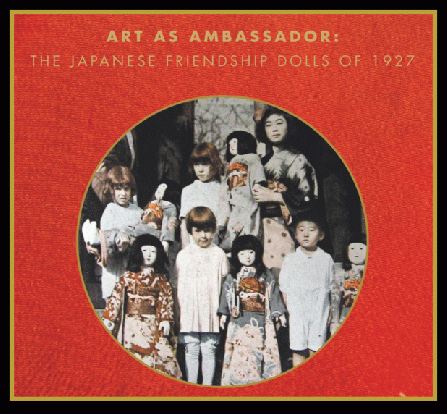The Japanese and "Blue-eyed" Friendship Dolls are genuine ambassadors of peace. They have transcended politics and outlasted wars. Even though some of them are missing, the heart-to-heart acts of friendship they inspired cannot be lost or destroyed--these memories are always a part of us, and the feelings of comaraderie and connection cascade into the hearts of following generations.
The author of this article wishes to thank Rosie Skiles for her assistance in providing contacts and information. A past president of J.A.D.E. (Japanese-Asian Doll Enthusiasts) Skiles' tireless work has resulted in the discovery of several Torei Ningyo dolls, as well as unraveling the mysteries of the mis-identifications of many of the dolls.Alan Scott Pate is the leading authority outside of Japan on antique Japanese dolls. He is author of the 560-page, Art as Ambassador: The Japanese Friendship Dolls of 1927. With nearly 400 photos, it is the definitive publication on the history and art of the 1927 exchange of dolls between the US and Japan. Most of the photos in this article are from his book.
L-R: Alan Scott Pate, Miss Miyazaki and Aoki Masaru, who is largely responsible for coordinating the conservation of the Friendship Dolls when they return to Japan.
(Image by courtesy Alan Scott Pate) Details DMCAMeryl Ann Butler: Thanks for visiting with us, Alan, and for sharing images from your stunning book. How did you get interested in the project?
'Art as Ambassador: The Japanese Friendship Dolls of 1927' by Alan Scott Pate
(Image by courtesy Alan Scott Pate) Details DMCA
Alan Scott Pate: I've been focused on antique Japanese dolls since 1993. My interest was initially in early dolls from the 18th-19th centuries. And while I had certainly heard of the Friendship Dolls, I considered them too modern to be of interest.
However, in 2002 I was given the opportunity to acquire Miss Fukushima from a private collector. I took her back to Japan for conservation and to facilitate a homecoming for this doll for the people of Fukushima Prefecture.
At first I considered it a simple business transaction. What I was entirely unprepared for was the mountains of letters I received thanking me for bringing Miss Fukushima home. This included photographs and letters from women who remembered the original farewell party held for Miss Fukushima in October of 1927!
I got goose bumps reading the letters and seeing photos of quite elderly women crying at the sight of Miss Fukushima, or holding up old newspaper clippings of the 1927 event that they had saved all of their lives! It suddenly hit me that this was more than a doll, and it was certainly more than a simple business transaction.
This story of the doll exchanges, though nearly 80 years old at that time, was still a living thing. Miss Fukushima was not a relic from a by-gone day, she was still immensely relevant. So I do what I always do when I get interested in something. I research! And I found that only one book had ever been published on the Friendship Doll exchange, and that was in 1929 when the story was still unfolding.
So I assigned myself the task of visiting every known doll, photographing them and documenting their journey, doing archival digs in museums, libraries and historical societies from one end of the country to the other. I assigned myself two years for the project--it took ten!
Along the way three more dolls were brought to light: Miss Gunma, Miss Nagano/Aichi, and Miss Miyazaki.
And I was able to help facilitate their returns to Japan for conservation and Homecoming ceremonies, rekindling the links between communities in Japan and individuals here in the United Sates. So even now that the book is done, I realize that my work with the Friendship Dolls is just beginning.
MAB: Well you're off to quite a "beginning," Alan, thanks for visiting with us and please keep us updated.
'Art as Ambassador: The Japanese Friendship Dolls of 1927' by Alan Scott Pate
(Image by courtesy Alan Scott Pate) Details DMCA
(Note: You can view every article as one long page if you sign up as an Advocate Member, or higher).








